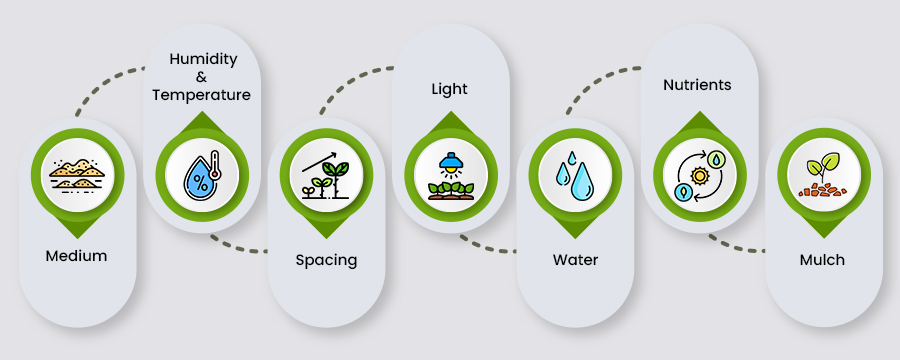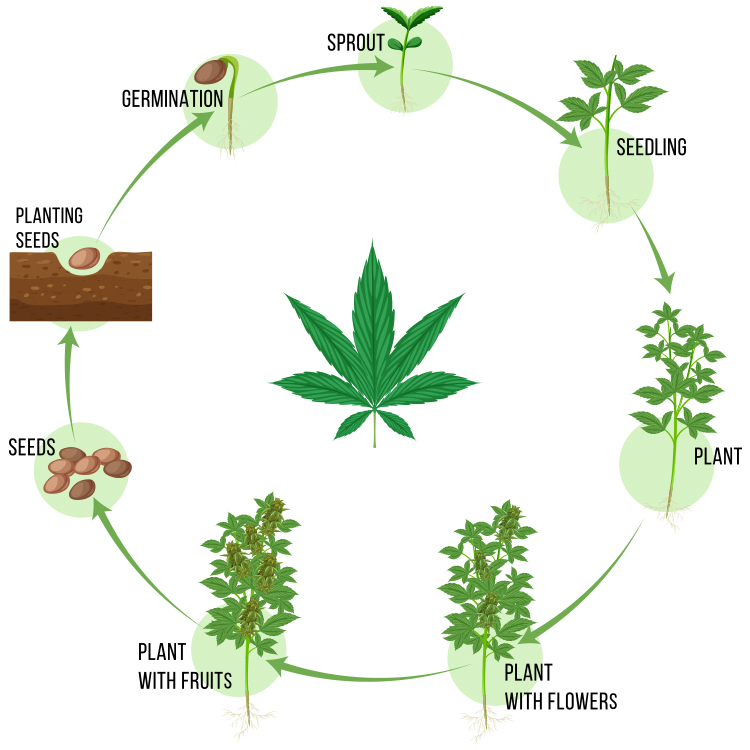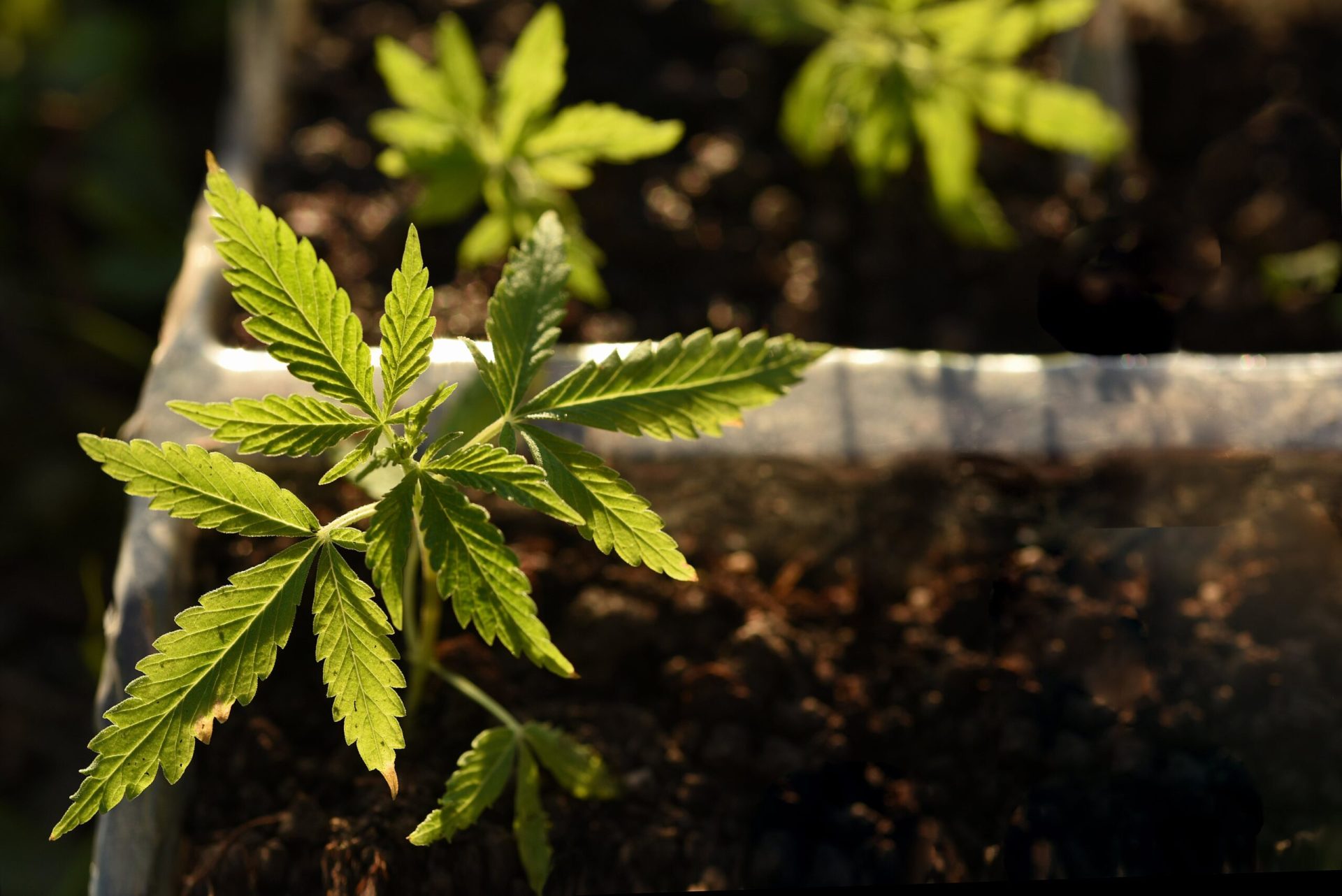Growing cannabis at home is a rewarding endeavor. Whether you want to grow cannabis for recreational or medicinal purposes, growing strong plants starts with understanding the basics.
From choosing the right cannabis seeds, to cannabis plant growing stages and basic planting requirements, this guide will help you grow stronger, higher-yield plants. Ultimately, the plant is commonly referred to as “weed”, because it grows like a weed. However, even though it grows on its own, a few special steps will ensure you grow the most potent cannabis plants.
Growing Cannabis 101: Step-by-Step Guide

Before you start growing cannabis at home, gather the essential supplies. Typically, to grow strong, healthy plants you will need:
1. Soil is a growing medium
Cannabis requires reliable medium. This could include specially prepared soil or an alternative cannabis grow medium like coco coir. The right growing medium supports the development of healthy roots and promotes overall growth and well-being. Some of the most popular grow mediums include:
- Coco coir (for hydroponic systems)
- Perlite (for hydroponic systems)
- Soil mixes (for indoor and outdoor growing)
Choose a soil blend that is nutrient-rich and includes organic ingredients like worm castings, compost, guano and other nutrients. For indoor grown plants, coco coir is another popular mix.
2. Humidity & Temperature
Regulate heat and moisture in the growing environment, especially if you are cultivating cannabis plants indoors. A temperature between 65-85° F and humidity around 40-50% offers the best environment.
During the flowering stage, lower the humidity level to prevent the rotting of cannabis buds. You can use various machines like a ventilator, fan or a dehumidifier.
3. Spacing
For outdoor cannabis cultivation, each plant requires about 6-10 square feet of growing space. The required space depends on the number of plants grown, the strain selection, and the desired size.
The typical recommended space for indoor cultivation is between 20 to 50 square feet of space for each plant, which includes walkways. However, this might vary based on the strain size, the growing techniques you use, and the desired yield. For example, using a technique like low stress training allows you to fit more plants into a smaller space.
4. Light
Indoor lighting is essential for growing cannabis from seed. Research suggests cannabis grows best under varying types of light. Invest in high-quality grow lights (LED or HPS) to offer the right spectrum and intensity for each growing stage. Cannabis requires a lot of light, especially during its flowering stage.
5. Water
You should give your plants adequate water from a nutrient-rich source. A rule of thumb: It’s time to water when the top layer of soil or growing medium gets dry.
Use pH-balanced water and provide essential nutrients as per the growing stage of plants. Overfeeding or underfeeding both can be harmful, so follow a proper feeding schedule.
6. Nutrients
Cannabis primarily requires three major nutrients: Nitrogen (N), Phosphorus (P), and Potassium (K), although some other micronutrients and minerals are beneficial.
Provide your cannabis plants with a well-rounded nutrient formula. (There are various liquid nutrients that will ensure maximum yield.) You can opt for a top-notch, organic nutrient brand for the healthy growth of cannabis plants.
7. Mulch
Mulch is good for growing cannabis because it keeps the soil moist, controls temperature, stops weeds, and makes the soil healthier. You can use mulch options like organic mulch, straw, wood chips, compost, and grass clippings for cannabis plants.
When applying mulch around plants, leave some space around the plant to allow air circulation and prevent stem rot. A layer of mulch about 2–4-inch thickness is sufficient to provide desired benefits. Consider your plants’ environmental conditions and needs when selecting and applying mulch for optimal growth and health.
How to Start Cannabis Seeds
Germinating cannabis seeds is relatively easy. And requires just a few supply items, including fresh cannabis seeds, seedling pots or trays, seed-starting mix, water, a light source (which could be artificial light or a sunny windowsill), and a humidity dome (which is optional).
- Germination: Begin by soaking your cannabis seeds in room-temperature water for about 12-24 hours. This softens the seed coat and promotes germination. Transfer the seeds to a damp paper towel and place them in a plastic bag or container to create a humid environment. Watch for the seeds to sprout within a week, and once the taproot is about a quarter-inch long, they’re ready for transplanting.
- Transplanting: Fill your seedling trays with seed starting mix. Make a small hole about half an inch deep, gently place the germinated seed with the taproot down, and lightly cover the seedling with soil. Water the soil around the seed, being careful not to overwater to prevent rot.
- Light and Temperature: Provide a light source for your seedlings. Fluorescent or LED grow lights work well and maintain a temperature of around 70-75°F to promote early growth.
- Care and Transplanting: As the seedlings grow, keep the soil consistently moist but not waterlogged. After a few weeks, when they have several sets of leaves, they’ll be ready for transplanting into larger pots or directly into your chosen growing medium for the vegetative stage.
- Light Schedule: During the seedling stage, provide 18-24 hours of light per day to encourage healthy growth. Adjust the light schedule according to the growth stage and specific requirements of your cannabis strain.
Best Time to Plant Cannabis
The best time to plant cannabis depends on your location and the specific growing conditions in your area. Cannabis needs light to trigger the flowering stage. Here’s some helpful guidelines:
GROWING OUTDOORS – The planting timing depends on the climate of your region. As cannabis requires a lot of light, they are best started in spring to benefit from daylight hours. Wait to transplant seedlings outdoors until the last frost of spring. Also, be sure to harden off your seedlings by exposing them to progressively more light before transplanting outdoors.
GROWING INDOORS – The planting timing depends on the specific strain you plan to grow for the desired harvest. Since indoor growers have great control over the light cycle, they can grow it year-round any time.
Note: Be sure you comply with local laws and regulations regarding cannabis cultivation. Even in states where recreation cannabis is legal, cultivation may still be illegal. Check before you invest in growing supplies.
Cannabis Growing Stages

Indoor- and outdoor-grown cannabis follows a similar growth cycle. However, growing indoors will allow you to speed up plant growth, as you can control the amount of light each plant receives. However, no matter which method you use, your cannabis plants will go through these growth stages:
1. Germination
The germination process will take about 3 to 10 days. It is essential to provide a reliably warm environment without excessive moisture.
Some choose to direct sow seeds they’ve wetted. Once you’ve waited for germination, place the germinated cannabis seeds in moist, warm soil. Within a few days, seedlings emerge.
2. Seedling
During this stage, cannabis seedlings require plenty of light (18-23 hours) a day. A gentle breeze will help strengthen their stem. Ensure the environment is warm and humid.
Transplant the seedlings into large pots as they grow. It ensures that plants have enough room for their roots to spread.
3. Vegetative
In this stage, cannabis plants grow bigger and stronger. Provide the plants with a balance of light (18 hours a day) and darkness. Also, provide proper nutrients and water. We suggest pruning the plants selectively to encourage lateral growth and create a bushier plant.
4. Flowering
The light cycle of 12 hours of light and 12 hours of darkness helps initiate the flowering stage. Female plants start producing buds. During this stage, monitor the plants closely and adjust light, water, and nutrients as required.
How to Harvest Cannabis?
Knowing how to harvest cannabis at the right time is essential to make the most out of your crop. Pay attention to the pistils (the hair-like structures on the buds). When your plants are ready, the pistils will likely change from white to brown or red. When you notice that more than half of the pistils are brown, you can harvest the plants.
To harvest, cut off the stem at its root. Avoid uprooting the main stem, as this can be harmful to the plant and may result in a smaller yield.
After harvesting, it is essential to dry them properly before you stock them. The best way to harvest cannabis is to suspend the plant upside down in an area with plenty of airflow that’s not exposed to light. Proper ventilation is essential.
How to Cure Cannabis?
To preserve and store cannabis, there are two approaches: curing inside or outside
- When curing cannabis indoors, be sure to manage the humidity and temperature. Too much moisture can ruin your crop and result in mold. Maintain the humidity between 40%-60%.
- When curing cannabis outdoors, pay attention to the temperature and humidity level. Low temperatures can extend the curing process, and may even reduce the plant’s potency. High temperatures will dry the plants too quickly, reducing potency and flavor. To preserve flavor, avoid exposing them to direct sunlight during the curing process.
Best Cannabis Types to Grow at Home

The two main types of cannabis are Sativa and Indica. However, there are four options. Each has its own distinct aroma, taste, appearance, and effects. Within each of these types, you can try different individual strains.
For example, Sour Diesel is a popular Sativa strain, while Northern Lights is a well-known Indica. Here is a brief overview of the four different types:
1. Sativa: Sativa strains possesses a tall and slender appearance with narrow leaves. Sativa cannabis usually grows taller and has a long flowering cycle. Sativa is often associated with uplifting, energizing, and cerebral effects.
2. Indica: Indica strains possess a short and bushier appearance with broad leaves. These strains have a fast-flowering cycle and are ideal for indoor cultivation. Indica is known for its relaxing, sedative, and body-calming effects.
3. Ruderalis: Ruderalis is a subspecies of cannabis with unique characteristics. This plant is famous for its ability to autoflower (e.g. the flowering stage doesn’t have to be triggered by light). Generally, it contains low levels of THC and people do not commonly use it for medicinal or recreational use. However, newer strains are becoming popular among indoor growers.
4. Hybrid: Hybrid strains grow from both Sativa and Indica plants. Growers cultivate hybrid strains to increase the THC percentage, but the percentage can vary depending on their intended use. Hybrid strains can classify as Indica or Sativa dominant or balanced, based on the THC-CBD ratio.



